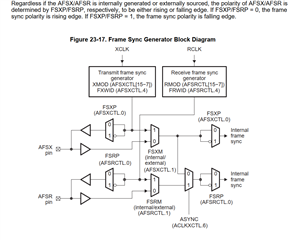Other Parts Discussed in Thread: PCM1808
In SPRUH79C 23.0.21.3 Frame Sync Generator,It says:
-------------------------
Regardless if the AFSX/AFSR is internally generated or externally sourced, the polarity of AFSX/AFSR is
determined by FSXP/FSRP, respectively, to be either rising or falling edge. If FSXP/FSRP = 0, the frame
sync polarity is rising edge. If FSXP/FSRP = 1, the frame sync polarity is falling edge.
-------------------------
If the AFSR polarity is a falling edge, as in the I2S format, set the FSRP bit to 1.
At this time, if FSRM = 1, "Internal frame sync" will fall at the beginning of the frame.
On the other hand, if FSRM = 0, "Internal frame sync" will rise at the beginning of the frame.
This behavior is considered to be inconsistent with the comments above.








